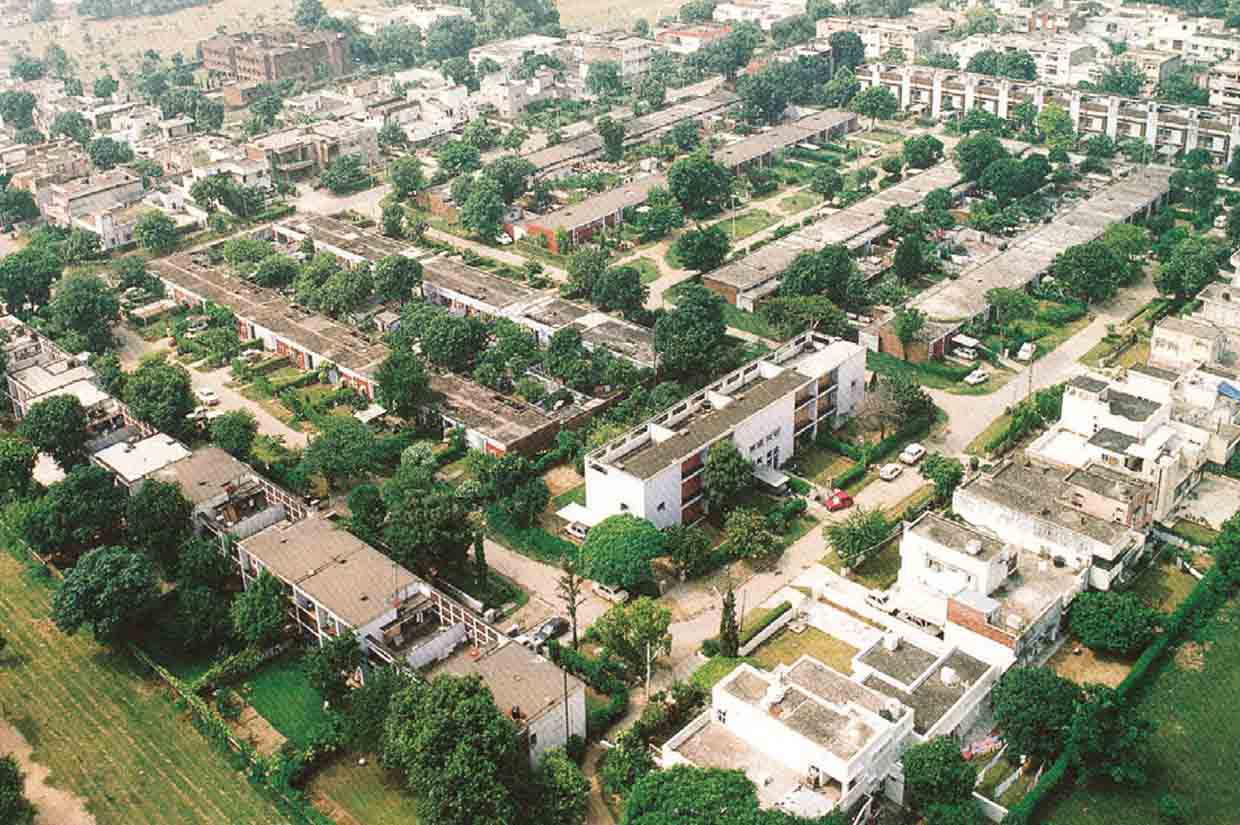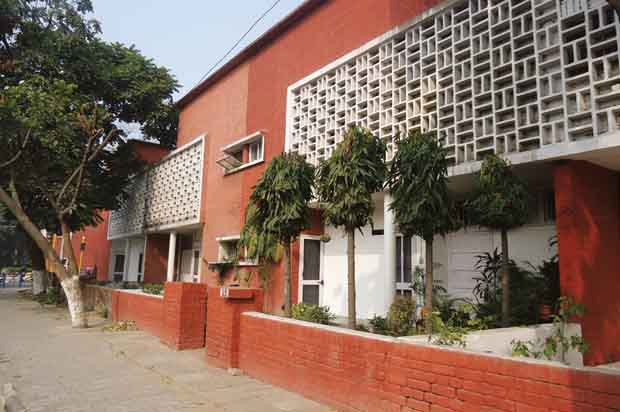Affordable housing has been the agenda for discussion in diverse forums. Affordability is also a difficult term to qualify as it would depend upon a host of parameters and vary within different economic zones in countries with cities and towns of different sizes. Broadly speaking ‘affordability’ would try to address the paying capacity of the individual and his ability to shell out from his income and savings an amount that would not only allow him to look after the needs of his family but also secure a shelter for them.

The city of Chandigarh and new housing design are synonymous. Chandigarh has many firsts to its credit such an underground sewage disposal system and piped water supply to each house in post-Independence India. One of the salient features of the city plan was the laying of basic urban infrastructure at the right time. Tucked away underground – with due respect to the lay of the land and water table levels – was a grid comprising the supply and disposal of water as well as sewerage lines, while the city’s network of roads was right above. The responsibility of laying basic urban infrastructure was undertaken by the city administration as its responsibility, so that housing and other functions could be realised thereafter.
Being a government capital city, as a counterpoint to the loss of Lahore to Pakistan in the wake of India’s Partition, development of a robust housing stock was one of the key mandates of the administration. A conscious decision was taken to build 13 categories of house types on the basis of an employee’s monthly salary. In return, the employee was required to pay ten percent of his salary as rent every month, which would go into the government exchequer for house and precinct maintenance. The 13 categories included type 1 as the chief minister’s bungalow and type 13 as peon and staff housing, which served the government machinery. Within the two sides of this housing matrix resided the officers, clerks and other staff. However, following the democratic and egalitarian principles of the new capital city, each house had piped water supply and a bathroom with an underground sewerage disposal system. In very small but sure ways, this was the new capital city’s first embrace of modernity and contributes to the city’s high quality of life, affordability and popularity index.
In this town, affordability of state-owned housing stock brought with it beauty and aesthetics through the ‘equipement rationnel ’
The 13 categories were combinations of single, double and duplex housing typologies, set in cul-de-sac garden landscapes, free from crisscrossing traffic. The commonality of building materials unified to create the Chandigarh style of architecture. Low rise, brick and plaster, painted white surfaces, courtyards and terraces, terracotta, screens and sun breakers as well as deep insert windows and projecting brick overhangs constitute the city’s urban fabric and the fine grain and uniform texture of the neighbourhoods. This is easily identifiable as typical Le Corbusier: modernist, minimal and purposeful.

SOURCE: JOSHI, KIRAN 1999, THE INDIAN ARCHITECTURE OF PIERRE JEANNERET, MAXWEL FRY AND JANE DREW, CHANDIGARH ADMINISTRATION, MAPIN, INDIA.
The housing types were designed in response to the three dictates governing the city’s design. Jane Beverley Drew, the English architect who was responsible for designing many of the house types, skilfully utilised her experience of working in the hot and humid climates of Ibadan, Ghana and other English territories to develop self shading, courtyard and perforated screens, sun breakers and brise-soleil (an architectural feature of a building that reduces heat gain within that building by deflecting sunlight), which on the one hand tackled the climate and on the other provided the visual privacy essential to the cultural ethos of the Indian lifestyle. Together with her husband Maxwell Fry and Pierre Jeanneret (her most staunch opponent on the team), the trio brought together local men, materials and methods to arrive at a new definition of affordability in Chandigarh.
Affordability is often devoid of higher orders and sensibilities such as beauty and aesthetics. In this town, affordability of state-owned housing stock brought with it beauty and aesthetics through the ‘equipement rationnel’: a term used to define the minimalist architecture of the city. The utilisation of basic building materials even in the interiors of houses of all categories through elements such as built-in furniture, lighting fixtures, fire places, chimneys, flues, vents, which were an extension of the microclimatic amelioration elements, reflects the equipement rationnel. Projecting bricks for sunbreaks, louvres for shade and sunray deflection and brise-soleil to mitigate heat penetration were all exterior elements lending the identifiable character to modernist housing. The aesthetics of the Chandigarh style were thus born out of the functional and the essential rather than the decorative.
Who will reside in Chandigarh if the original inhabitants leave due to ill affordability?
The housing stock performed well as the city grew and filled in. While phase one of the city engaged in the 13 categories of housing, walkup four-storey apartments and later six-storeyed houses were seen as housing solutions for phase two of the growing capital of Chandigarh to provide affordable housing to its employees. Slowly, with the city maturing and an increase in vehicle density and population pressure, there was another challenge to be addressed. The state-owned government accommodation had to be surrendered by the employee at the age of retirement and he had to move into private housing either within Chandigarh or its two neighbouring tricity towns: Mohali and Panchkula. The first phase of the city had a mix of government houses and private plots, while phase two was more of the apartment type.

Middle: The reflections of the state-owned government housing stock were amply visible in the privately-owned and built houses
Right: The present day house forms and typologies represent an architecture from ‘anywhere and everywhere’.Isthisa reflection of a 20th century modern city?
However, land is a fixed commodity here and so Chandigarh’s population boom has left little for the employees to look at after retirement. Land values have increased exponentially and the real deserving citizens have been marginalised by the rich farmers of the hinterland who can afford the plots in the city. The responsibility of the state lies in providing ‘affordable housing’, but the supply
is a far cry from the demand. Subsidised housing offered by the Chandigarh Housing Board is a weak mechanism and inflation rates leave much to be desired. By the time the housing board flat is ready for occupation, its market value is way beyond the base price and the owner finds it more lucrative to sell off and move to the outskirts.
The big question remains: who will reside in Chandigarh if the original inhabitants leave due to ill affordability? The city would lose its original character and turn into another run-of- the-mill city. The administrators need to find a solution so that the original intent of planning is not compromised and the original citizens are not marginalised by the affluent few. The laws of the land need to be revisited safeguarding the interests of the employees, who are currently being pushed to the outskirts. The solutions need to be more informed and based upon principles of egalitarian order, which was the mandate at the city’s inception. As a forerunner of civic design for the country’s post-Independence cities, Chandigarh’s housing stock, both state- owned and privately-built and owned, must be regulated with special legislation for ownership, degree of permissible transformations, heritage guidelines and regulations. Through this the city can embrace modernity yet again and be the torchbearer for others following its path.
- Sangeeta Bagga-Mehta is a Professor at the Chandigarh College of Architecture and has conducted multiple collaborative workshops addressing urban landscapes and social issues in Chandigarh. A jury member of the Berkeley Student Essay Prize and Nodal Officer for the Trans-national Serial Nomination of Chandigarh’s Capitol Complex to UNESCO. She is also Coordinator, National Scientific Committee 20c Heritage, ICOMOS India.



Comments (0)